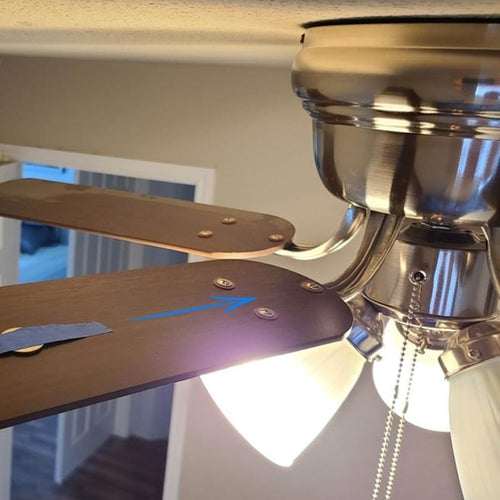
Ceiling fans are a great way to keep your space cool and comfortable. But there’s nothing more frustrating than a wobbly or rattling fan. When your ceiling fan starts wobbling it’s not just a visual annoyance. The uneven blades can damage the motor bearings over time. If you’re sick of the rattling and want your fan to spin evenly again— this guide will show you how to balance your ceiling fan in 5 minutes!
What Causes a Wobbling Ceiling Fan?
Before we get into how to fix the wobble, let’s first understand what might be causing it. Ceiling fan wobbling is a common problem but it doesn’t always mean something is broken. Sometimes a few simple adjustments will do the trick. Here are the most common reasons for a wobbling ceiling fan:
-
Loose Blade Screws or Brackets – The screws that hold your fan blades in place can come loose over time especially if the fan has been running for a while.
-
Dust and Dirt Buildup – Dust and debris can accumulate on the blades making them heavier on one side than the other.
-
Warped or Damaged Blades – Any physical damage to the blades can make them uneven and wobble.
-
Misaligned Blade Holders – If the brackets that hold the blades in place are misaligned this can cause an imbalance.
-
Bent Motor Shaft – A bent motor shaft will make the fan spin unevenly.
-
Bad Installation – If the fan isn’t installed correctly it may not be level and will wobble.
Now that you know what’s causing the wobble you can start balancing your ceiling fan.

Step-by-Step Guide to Balancing a Ceiling Fan
Balancing a ceiling fan is not as hard as it sounds, with the right tools and a little time you can do it yourself. Here’s how:
What You’ll Need:
-
Stepladder
-
Screwdriver
-
Cleaning cloth
-
Ruler or yardstick
-
Masking tape
-
Balancing kit (if needed)
If your fan wobbles a lot you might want to get a balancing kit which usually comes with:
-
Plastic clips
-
Adhesive weights
-
Instructions
Step 1: Turn Off and Clean the Fan
First turn off the fan at the wall switch. Make sure it stops completely before you start working. Once it’s off use a damp cloth to clean each blade. Dust and dirt can add to the imbalance so this step is important for a smooth running fan.
Step 2: Inspect and Tighten Blade Screws
Next inspect each fan blade. Check for any loose screws or brackets. These can be a big cause of wobble. Use a screwdriver to tighten any loose screws. Don’t overtighten them as this can damage the blades or strip the screws. Proper installation is key, just like Yiosilamp’s attention to detail in their lighting. Make sure everything is secure before you move on.
Step 3: Check the Balance
Now the blades are clean and the screws are tight it’s time to check the balance. This is where precision is important. Yiosilamp’s custom lighting requires precision installation and so does your ceiling fan. Here’s how to check the balance:
-
Place a piece of masking tape on the edge of each blade. Number each piece so you can keep track of which blade is which.
-
Use a ruler or yardstick to measure the distance between the leading edge of each blade and the ceiling. Keep the ruler vertical and measure from the same spot on the ceiling for consistency.
-
If one blade is further from the ceiling than the others gently adjust the blade’s bracket. You can bend the bracket up or down to level the blade.
Make sure to watch the fan closely. You should be standing on a ladder at eye level with the fan blades to get the best view. Use an object like a doorway or window as a reference point to check for even blade height.
Step 4: Use a Balancing Kit
If the wobble persists after you’ve adjusted, use a balancing kit. This comes with a plastic clip that you attach to one of the blades to find the source of the wobble.
-
Attach the clip to the trailing edge of the blade you think is causing the wobble.
-
Turn the fan on and watch.
-
Move the clip towards the blade end or closer to the motor until the wobble stops.
You may need to try different positions for the clip to find exactly where the wobble stops. This takes some patience but with careful testing you can find the problem.
Step 5: Add Weights
If the clip test works and stops the wobble, it’s time to add the adhesive weights from your balancing kit. Here’s what to do:
-
Temporarily attach one of the weights to the top of the blade, near the centerline.
-
Remove the clip and run the fan to see if the wobble has stopped.
-
If it works, mark the position of the weight and stick it in place.
-
Repeat on other blades if needed until the fan runs smooth.
Wobbles Won’t Go Away?
If the above didn’t fix the wobble, don’t worry — there’s more to check.
Check Warped or Damaged Blades
Take each blade off and lay it on a flat surface to see if it’s curved or twisted. If any are warped or damaged, replace them. Warped blades can be the cause of wobbles so replace if necessary.
Check the Mount
Sometimes it’s the fan’s motor mount or installation. To check everything is in place:
-
Make sure the mounting bracket is screwed to the electrical box.
-
Check the down rod (if fitted) isn’t bent and is seated in the mount.
-
Ensure the canopy (the part that covers the mount) is flush to the ceiling.
If any of these are loose or not aligned it can cause the fan to wobble. Tighten or align these and it should fix the problem.
Preventative Maintenance
Preventing ceiling fan wobble starts with maintenance and good products, much like how regular cleaning can extend the life of chandelier lights or pendant lights. One of the best ways to keep your fan running smooth is to clean the blades. Dust and dirt can accumulate unevenly and cause an imbalance that wobbles the fan. Use a damp cloth to wipe each blade so there’s no buildup that can throw the fan off balance. Also check the screws and brackets every few months. Over time the vibrations from use can loosen these parts and compromise the fan’s stability. Tighten them every now and then and everything will stay in place.

Troubleshooting Checklist
If your ceiling fan still wobbles after you’ve balanced it, here’s a few things to check. First check all screws and mounts. A single loose screw in the blade or mounting bracket can throw the fan out of balance. Next check the electrical box to make sure it’s securely attached to the ceiling and can support the fan’s weight. An unstable box will cause the whole assembly to wobble.
Make sure the downrod (if your fan has one) is seated properly in its mount. A bent or misaligned downrod will cause uneven spinning. Finally check the motor and other parts for wear or damage. Over time parts like bearings can wear out and affect the fan’s performance. Fix these issues ASAP and you’ll have a quiet and stable ceiling fan.
When to Call a Pro?
While you can balance a ceiling fan with basic tools, sometimes the problem goes beyond what basic maintenance can fix. If you’ve tried balancing the fan and the wobble persists, or if the fan is making weird noises, it’s probably more than what you can handle.
Here’s when to call a pro:
-
Wobble Persists After Balancing: You’ve used a balancing kit, cleaned the fan, and tightened screws and the wobble still remains, it’s probably the motor or installation itself.
-
Weird Noises: If your fan is making scraping or grinding noises, it’s probably the motor or the motor’s bearings. In that case a pro may need to replace the motor or other parts.
-
Loose or Damaged Mounting: If the fan’s mounting bracket is loose or if the fan is hanging at an odd angle, it may need to be realigned or reinstalled.
Importance of Energy Efficiency
A balanced fan is not just about comfort and noise— it’s about energy efficiency. When a fan wobbles the motor is working harder to maintain speed and performance. That extra load consumes more energy and shortens the life of the motor. By balancing your fan you get smooth operation, even air flow and your fan can run at lower speeds and still be comfortable, saving energy and your utility bill.
The same applies to lighting solutions where energy efficient design minimizes waste and maximizes performance. Yiosilamp’s LED fixtures and modern lighting solutions are designed to give you great light while consuming much less power than traditional options. Just like a balanced fan optimizes energy use through smooth operation, Yiosilamp’s products save energy through advanced materials and design. LEDs for example convert most of the energy they consume into light not heat, making them the best choice for sustainable lighting. Investing in energy efficient products whether fans or lighting reduces environmental impact and gives you long term savings and reliability.
Conclusion
Balancing a ceiling fan doesn’t have to be scary. With the right tools and techniques you can get your fan running smooth and quiet again. Follow the step by step instructions to inspect, clean, tighten and adjust the fan blades. If needed use a balancing kit or call a pro. By maintaining your fan and making sure it’s installed correctly you can prevent future wobble issues.
And don’t forget, just like choosing the right Yiosilamp lighting fixture for your space, choosing a good ceiling fan will save you from maintenance and performance issues for years to come.
If you want to buy a fan or need more lighting solutions, Yiosilamp has experts familiar with lighting trends 2025 and high-end products to help you get your space looking and feeling perfect.
Read More:
How High to Hang a Chandelier Over the Dining Table?
15 Amazing Small Bedroom Lighting Ideas
15 Bathroom Lighting Ideas Over Mirror
15 Amazing Bathroom Lighting Ideas For Ceiling




